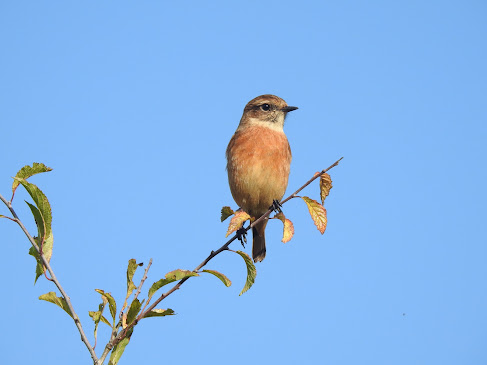As I was queuing in the chemist yesterday morning the day took an unexpected turn as my phone pinged. It was a message from Tony with some photographs of a striking Wagtail he had ringed the previous evening at Morton Bagot. The accompanying picture made my jaw drop. It reminded me of an Amur Wagtail, a Siberian mega-rarity which shouldn't be turning up in a Wagtail roost near Redditch.
 |
| The Wagtail per Tony K |
The white flanks were completely at odds with those of a Pied Wagtail, and apart from what I took to be a couple of displaced dark feathers the greater coverts looked white.
I dashed home and conveyed my thoughts to Tony, asking whether he made had any descriptive notes. It turned out that he had been ringing alone, had caught another 20 normal Pied Wagtails and a couple of Starlings which had taken a while to extract, so he had been in no position to do anything other than take a series of photos. He shared these with me.
 |
| The Wagtail - per Tony K |
This second photo showed one or two anomalous features. The Black bib appeared to be linked to the side of the breast (when it should have been isolated and small) and there was an obvious grey patch on the breast sides (which should have been white). I only knew this after digging out an old British Birds article about the first British record.
 |
| The Wagtail - per Tony K |
In the third photograph the black bib did look a bit more isolated, but it was clear I needed to share the shots with other birders. I therefore messaged several birders and shared the photos on the two Whatsapp Groups I am in.
This proved very helpful. Matt Griffiths had noticed the presence of some white feathers in the black crown (this could indicate abnormal plumage, the sort of leucism you sometimes see on Blackbirds for instance). John on the Local Nature Sightings Whatsapp Group posted a photograph of a similar bird on Scilly which had been mooted as a possible Amur Wagtail, before being demoted to "odd" Pied Wagtail. Andy Warr pointed out it appeared to have dropped most of its greater coverts making the wing look whiter than usual. Everyone who replied agreed it was a striking bird, but all felt it was probably not an Amur Wagtail.
So what was it?
My guess would be option 2, but in the absence of any further evidence we'll probably never know. I did say to Tony that if he catches it again he could remove a feather or two for DNA testing, something that is now seemingly routine when Observatory Staff catch a tricky bird.
Today I returned to the patch for some more run of the mill Morton Bagot birding. I was keen to photograph a typical male Pied Wagtail for comparison.
 |
| Male Pied Wagtail |
Not a very good shot, but it shows the typical greater covert pattern of black centred feathers and broad white tips, a large black bib, and grey breast sides (it also has grey flanks which are hidden by the way it was holding its wings) of a Pied Wagtail.
Also present today were more Stonechats, two Green Sandpipers, five Snipe, and the first Wigeon of the autumn.
 |
| Stonechat |
 |
| Wigeon |
Excitement over, it's back to reality.
No comments:
Post a Comment